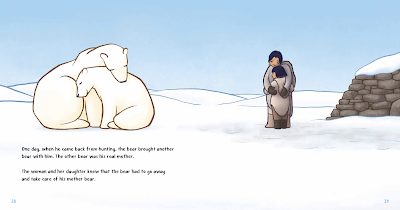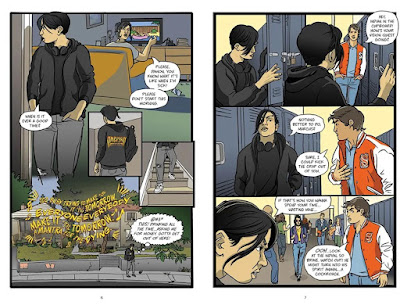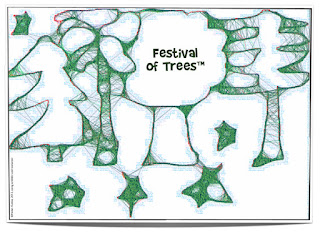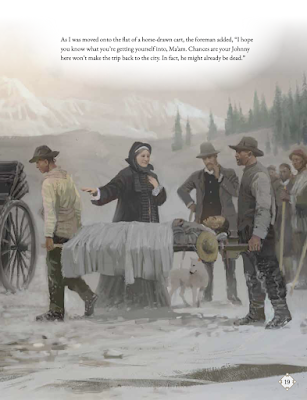If it's April, then young readers are voting for their favourite books in the Ontario Library Association's
Forest of Reading® award programs. And those votes will be tallied and awards announced at the
Festival of Trees. These award ceremonies were always a big event at Toronto's Harbourfront, though over the pandemic, award ceremonies were conducted online. For the first time in several years, young readers will have the opportunity to attend in-person events which include workshops by authors and/or illustrators, get their books autographed by authors, and cheer in person when the award winners are announced. The Festival of Trees will be held from Tuesday May 16 through Thursday May 18, 2023. If you're still not convinced to attend (tickets available here), check out the
full schedule of events below.
TUESDAY, MAY 16, 2023
AWARD CEREMONY 10:30-11:30 AM
WORKSHOPS
11:45 AM-12:15 PM Eric Walters: Bear in the Family
12:15-12:45 PM Shenaaz Nanji: Alina in a Pinch
12:45-1:15 PM Alma Fullerton: Flipping Forward Twisting Backward
AUTHORS AUTOGRAPHING
11:45 AM-12:45 PM
Alma Fullerton: Flipping Forward Twisting Backward
Greer Stothers: Kaleidoscope of Dinosaurs and Prehistoric Life: Their colors and patterns explained
Rachel Poliquin: The Strangest Thing in the Sea: And Other Curious Creatures of the Deep
1:00-2:00 PM
Shenaaz Nanji: Alina in a Pinch
Eric Walters: Bear in the Family
Juliana Armstrong: This is What I’ve Been Told / Mii yi gaa-bi-wiindmaagooyaan
Kallie George (tentative): Crimson Twill: Witch in the City
SILVER BIRCH FICTION
AWARD CEREMONY 12:00-1:00 PM
WORKSHOPS
10:15-10:45 AM
Colleen Nelson:
The Undercover Book List
10:15-10:45 AM J. Torres and David Namisato: Stealing Home
10:30-11:00 AM Wesley King: Butt Sandwich & Tree
11:15-11:45 AM Catherine Egan: Sneaks
11:15-11:45 AM Meagan Mahoney: Meranda and the Legend of the Lake
1:15-1:45 PM David A. Robertson: The Stone Child (The Misewa Saga, Bk 3)
AUTHORS AUTOGRAPHING
10:00-11:00 AM
Rosena Fung: Living with Viola
Meagan Mahoney: Meranda and the Legend of the Lake
Catherine Egan: Sneaks
David A. Robertson: The Stone Child (The Misewa Saga, Bk 3)
1:00-2:00 PM
Wesley King: Butt Sandwich & Tree
Colleen Nelson: The Undercover Book List
J. Torres and David Namisato: Stealing Home
BLUE SPRUCE
DIGITAL AWARD CEREMONY 1:30-2:00 PM EST
• • • • • • •
WEDNESDAY, MAY 17, 2023
RED MAPLE
AWARD CEREMONY 10:30-11:30 AM
WORKSHOPS
11:45 AM-12:15 PM Teresa Toten: Eight Days
12:15-12:45 PM Meaghan McIsaac: The Bear House
12:15-12:45 PM Chad Lucas: Let the Monster Out
12:45-1:15 PM Kevin Sands: Children of the Fox (Thieves of Shadow, Bk 1)
1:15-1:45 PM Paul Coccia and Eric Walters: On the Line
1:15-1:45 PM Lori Weber: The Ribbon Leaf
AUTHORS AUTOGRAPHING
11:45 AM-12:45 PM
Kevin Sands: Children of the Fox (Thieves of Shadow, Bk 1)
Paul Coccia and Eric Walters: On the Line
Lori Weber: The Ribbon Leaf
Joanne Levy: Sorry for Your Loss
Kathy Kacer: Under the Iron Bridge
1:00-2:00 PM
Leisl Adams:
Batter Royale Meaghan McIsaac:
The Bear House
Teresa Toten: Eight Days
Chad Lucas: Let the Monster Out
WHITE PINE
AWARD CEREMONY 12:00-1:00 PM
WORKSHOPS
10:15-10:45 AM Christy Goerzen: River Mermaid
10:15-10:45 AM H. N. Khan: Wrong Side of the Court
10:30-11:00 AM Kate McLaughlin: Daughter
11:15-11:45 AM Nicola Davison: Decoding Dot Grey
11:15-11:45 AM Jen Ferguson: The Summer of Bitter and Sweet
AUTHORS AUTOGRAPHING
1:00-2:00 PM
Kate McLaughlin: Daughter
Nicola Davison: Decoding Dot Grey
Christy Goerzen: River Mermaid
Jen Ferguson: The Summer of Bitter and Sweet
Louisa Onomé: Twice as Perfect
H. N. Khan: Wrong Side of the Court
YELLOW CEDAR
Digital Award Ceremony 1:30-2:00 PM EST
• • • • • • •
THURSDAY, MAY 18, 2023
LE PRIX MÉLÈZE
AWARD CEREMONY 10:30-11:30 AM
WORKSHOPS
11:45 AM-12:15 PM Andrée-Anne Gratton: L'enfant qui jouait du piano dans sa tête
11:45 AM-12:15 PM Marie-Andrée Arsenault: La Guerre des pupitres
12:15-12:45 PM Patrick Blanchette: Aube du monde des rêves 01 Le réacteur onirique
12:15-12:45 PM Carole Tremblay: La chose dans l'étang
12:45-1:15 PM Jocelyn Boisvert: La ligue des (pas si) champions
12:45-1:15 PM Pierre Chastenay: Une visite guidée du système solaire
AUTHORS AUTOGRAPHING
11:45 AM-12:45 PM
Jocelyn Boisvert: La ligue des (pas si) champions
Pierre Chastenay: Une visite guidée du système solaire
1:00-2:00 PM
Patrick Blanchette: Aube du monde des rêves 01 Le réacteur onirique
Carole Tremblay: La chose dans l'étang
Andrée-Anne Gratton: L'enfant qui jouait du piano dans sa tête
Marie-Andrée Arsenault: La Guerre des pupitres
LE PRIX TAMARAC
AWARD CEREMONY 12:00-1:00 PM
WORKSHOPS
10:15-10:45 AM Annie Bacon: Chroniques post-apocalyptiques d'un garçon perdu
10:15-10:45 AM Dïana Bélice: L'escouade du bonheur
10:30-11:00 AM Isabelle Roy: Brûlé 01 Premier degré
10:30-11:00 AM Marie-Hélène Jarry: Les carnets de novembre
11:15-11:45 AM Simon Lafrance: Carnet de bord d'un (aspirant) chef de meute
11:15-11:45 AM Alexandre Côté-Fournier: Quincaillerie Miville
1:15-1:45 PM Suzanne Aubry: Le Septième étage et demi
AUTHORS AUTOGRAPHING
10:45-11:45 AM
Isabelle Roy: Brûlé 01 Premier degré
Marie-Hélène Jarry: Les carnets de novembre
Suzanne Aubry: Le Septième étage et demi
Paul Tom: Seuls
Gabrielle Boulianne-Tremblay: La voix de la nature
1:00-2:00 PM
Simon Lafrance: Carnet de bord d'un (aspirant) chef de meute
Annie Bacon: Chroniques post-apocalyptiques d'un garçon perdu
Dïana Bélice: L'escouade du bonheur
Alexandre Côté-Fournier: Quincaillerie Miville
LE PRIX PEUPLIER
Digital Award Ceremony: 1:30-2:00 PM EST
Links to purchase tickets for these
Festival of Trees (including General Admission tickets without award ceremonies but all other events) as well as those that are only available as Digital Ceremonies (Blue Spruce, Yellow Cedar and Le prix Peuplier) are available at
https://forestofreading.com/festival/.














































